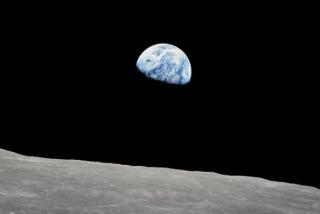Experts Study an Earth That Stretches and Swells : Geophysics: Forces within and without continually alter the not-quite-round planet, researchers find.
SAN FRANCISCO — After studying the works of French intellectuals and others, Christopher Columbus was convinced that the world was not flat but a perfect sphere when he set off on his courageous but clumsy effort to prove it by sailing to Asia.
However, he badly miscalculated the globe’s circumference--an error that led him to mistake Cuba for Japan--and erroneously concluded after his third voyage to the New World that Earth actually resembled a pear, according to UCLA Professor Norman J. Thrower.
Today, Thrower and other scientists generally agree that Earth is ellipsoid--a slightly flattened sphere that is broader across the Equator than it is through the poles. And it is rarely the same shape for long.
And a group of geophysicists at a meeting here of the American Geophysical Union concluded Tuesday that powerful forces from within and without continually alter the shape of the globe.
The changes are slight but detectable--and they have measurable effects on phenomena from tides to gravity.
Using superaccurate lasers and superconducting gravity meters, scientists are constructing an increasingly complex model of the “geoid.”
Earth, which appears spherical to casual observers, actually assumes slight variations of its basic ellipsoid. Pulling and tugging on this shape are such varied factors as a slow “bounce-back” phenomenon of land once compacted by glaciers and the shifting weight of the oceans and atmosphere.
It is even stretched and shaken by occasional differences between its core and its crust: They don’t always rotate on the same axis.
Earth’s basic ellipsoidal shape--its diameter through the poles is about 13 miles shorter than a diameter at the Equator--is largely attributable to simple centrifugal force. The planet’s rotation causes its molten mantle, the thick layer of liquid rock between its core and its crust, to bulge in the middle.
But other forces come into play as well, scientists said.
Jim Merriam of the University of Saskatchewan in Canada said convection, the movement of fluid away from a heat source, adds another 1,600 feet or so to the equatorial swell.
Steve Nerem of the National Aeronautics and Space Administration added that even normal seasonal shifts in atmospheric density from poles to Equator can have a minute but measurable impact, pulling out the Equator another half an inch or so.
At the same time, even more subtle and temporary changes in the Earth’s surface are being created by the well-known theory of plate tectonics, which asserts that the globe is clothed by huge rock sheets that support the continents and are continuously colliding into, over and under one another.
Dave Smith, also with NASA, said evidence to support this idea is piling up from a host of extremely accurate laser, satellite and other measuring devices that can detect tectonic movements as small as one-eighth of an inch a year.
Most movement is far faster than that, he said. Hawaii, for example, moves 2 inches closer to Japan each year. Meanwhile, parts of Southern California’s coast slide about three inches farther north and Australia gallops almost four inches east.
“They all move about the way we thought they would move, based on sea-floor spreading and other known geologic and tectonic processes,” Smith said. “We have pretty good pictures now of how various locations are moving in relation to others, to within a couple of millimeters a year.”
Sea-floor spreading is the process by which molten rock from Earth’s mantle wells up through the gap created when two tectonic plates move away from each other. This phenomenon, a subject of difficult but intense research, is usually found on ocean bottoms.
“When Columbus sailed across the ocean, he had no idea there was another ocean (of molten rock) 3,000 kilometers below his ship,” Merriam said in a lighthearted reference to the mantle.
Just as the Italian mariner was driven to explore the true surface oceans, scientists today are driven to explore that metaphorical ocean between Earth’s crust and core.
And, like Columbus, they are making unexpected discoveries.
For example, Guy Masters of UC San Diego announced Tuesday that seismic tomography has revealed an anomalous, continent-size “structure” lurking in the hellish intersection of Earth’s mantle and core.
Masters said it is too early to speculate exactly what that structure might be, but seismic waves bouncing off it indicate it is probably chemical in nature, and not merely an extraordinarily hot part of the mantle.
“Whatever it is,” Masters said, “it is not dense enough to go into the core, but it’s too dense to stay in the mantle.”
Masters made his discovery by recording and analyzing the shock waves of distant earthquakes after they have traveled many miles through the mantle. He said he can distinguish waves that have bounced off the solid core or off the underside of the solid crust from those that pass straight through the mantle.
He said he made this discovery by analyzing the seismic waves generated by more than 2,000 earthquakes of magnitude 5 or greater that occurred throughout the world over the last 11 years.






